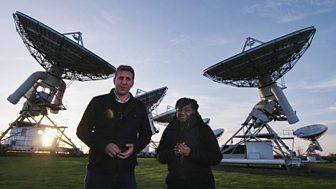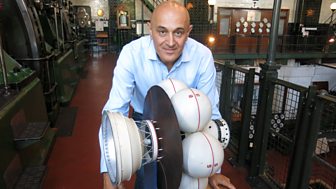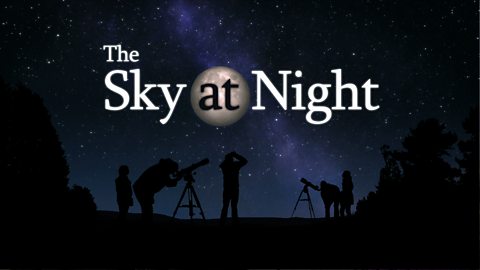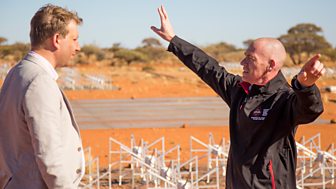
Death Star
One evening in early September 1859, a spectacular blood-red aurora borealis appeared across America. Earlier that same day, in a leafy garden in the UK, a gentleman astronomer had noted a 'white light flare' on the sun's surface.\n\nThe two events were linked; it's now known that the flare caused the aurora. The flare was a particularly violent eruption from the sun's surface known as a CME, a coronal mass ejection. Back then, it was considered an astronomical curiosity. But when it happens again, it will be a different story. For the modern, technological world such a violent solar phenomenon could be devastating. This episode examines just how damaging a CME could be and how astronomers, using two new satellites that will travel closer to the sun than ever before, can better prepare us for its impact.
Source: BBC 4
Most recent episodes of The Sky at Night
The Sky At Night
Asteroid Strike?
The team explore one of the biggest stories in space news, the ‘city killer’ asteroid 2024 YR4. First observed on 27 December 2024, it soon became one of the biggest ...
17-04-2025
BBC 4
The Sky At Night
Ancestral Skies
This month, The Sky at Night teams up with BBC Ideas to discover the secrets of archaeology and astronomy and to reflect on our ancestral skies. \n\nThroughout history and acros ...
14-11-2024
BBC 4
The Sky At Night
Question Time Special
Get ready for The Sky at Night’s annual Question Time Special, where viewers get the opportunity to ask the questions they have always wanted answered about our universe.\ ...
08-10-2024
BBC 4
The Sky At Night
2075: Our Place In Space
The Sky at Night is embarking on a journey into the future as we explore how space will revolutionise life on Earth over the next 50 years. As humanity's reach extends into the ...
11-09-2024
BBC 4
The Sky At Night
Nicky, Nasa And The Next Frontier
In this Sky at Night special, the team talk to Dr Nicola Fox, NASA’s head of science, whose life began in the UK.\n\nPresenter Chris Lintott chats to Nicky about her early ...
15-08-2024
BBC 4
The Sky At Night
Webb Telescope: The Story So Far
In July 2022, the James Webb Space Telescope released its first images. They were visually stunning, and it was clear they provided more detail of stars, galaxies and planets th ...
11-07-2024
BBC 4
The Sky At Night
Cosmic Ghosts
This month, The Sky at Night has a spooky twist. Across the universe, there are hidden objects that we can’t see, but astronomers and scientists still believe they’r ...
13-06-2024
BBC 4
The Sky At Night
Hiding In Starlight
Total solar eclipses, like the one seen last month in North America, allow us to see details of the Sun that can’t be seen at any other time. So, this month, The Sky at Ni ...
16-05-2024
BBC 4
The Sky At Night
Space Rock Return
The Sky at Night is back for a brand new series, and this month it is delving into Nasa’s OSIRIS-REx mission, which last year brought back a sample from the near-Earth ast ...
11-04-2024
BBC 4
Most popular episodes of The Sky at Night
The Sky At Night
Asteroid Strike?
The team explore one of the biggest stories in space news, the ‘city killer’ asteroid 2024 YR4. First observed on 27 December 2024, it soon became one of the biggest ...
17-04-2025
BBC 4
The Sky At Night
The Sky At Day
The British weather is often the enemy of stargazers up and down the country. A forecast of a couple of hours of cloud cover will disappoint even the most determined amateur ast ...
13-07-2022
BBC 4
The Sky At Night
Gaia: A Galactic Revolution
For past three and a half years, ESA's Gaia Space telescope has been mapping the heavens in unprecedented detail. At the end of April 2018 it released precise data on over 1.3 b ...
17-05-2018
BBC 4
The Sky At Night
The Invisible Universe
The Sky at Night reports on one of the most unnerving discoveries in space science - that most of the universe is missing.\n\nWe live in a material world, so instinctively we kn ...
18-01-2018
BBC 4
The Sky At Night
Guides: 1. Planets
The planets have fascinated us for millennia, but over the past 60 years our understanding of them has been transformed. Using The Sky at Night archives, Maggie Aderin-Pocock ta ...
17-05-2018
BBC 4
The Sky At Night
In The Blink Of An Eye
We're used to thinking that the universe operates on timescales of millions or even billions of years, where change happens with imperceptible slowness. But now we've discovered ...
16-11-2017
BBC 4
The Sky At Night
Guides: 2. Galaxies
Galaxies are the building blocks of the universe. Our solar system sits inside a huge galaxy that we call the Milky Way - home to as many as 300 billion stars. But the Milky Way ...
11-08-2019
BBC 4
The Sky At Night
Outback Astronomy
In February 2018, news broke that astronomers had seen the cosmic dawn - the moment when stars first formed, flooding the universe with light. What's remarkable is that this inc ...
12-07-2018
BBC 4




















